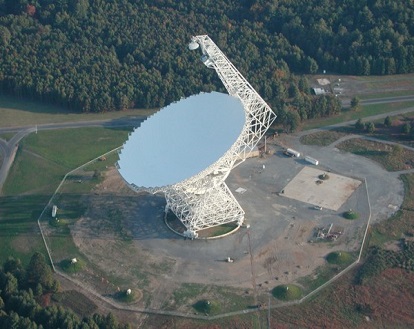(April 4, 2016, Kenneth Wyatt) With all the mobile communications we enjoy, along with the associated radio, television and cell phone transmitting towers, would you believe there is a place in the U.S. where all that is either prohibited or very closely controlled?
That place is the The National Radio Astronomy Observatory (NRAO) in Green Bank, West Virginia.
What originally caught my eye regarding the National Quiet Zone was Ed Hungness’ article, “Looking for Peace and Quiet? Go to West Virginia”. Hungness is a local columnist for the Traverse City (MI) Record-Eagle. Hungness started his article:
“Sometimes I long for the good ol’ days when there was one phone in the house and my belt didn’t have a cell attached to it. A Facebook was a picture album, a text was a school book, and tweets and twitters were heard in the morning when the birds woke up. I remember the sound of a dime being dropped into the slot of a payphone and the friendly voice of a local operator asking if she could be of service.
A place like this exists in the United States, surprisingly, and it is only 700 miles from Fife Lake. Green Bank, West Virginia, with only 143 residents, is the quietest populated place in America. Hidden away in the middle of the Allegheny Mountain Range, nestled in a green valley, it is centered in a 13,000-square-mile area designated as the National Radio Quiet Zone.”
The Observatory harbors the Robert C. Byrd Green Bank Telescope, or GBT, the world’s premiere single-dish radio telescope operating at meter to millimeter wavelengths. Its enormous 100-meter diameter collecting area, its unblocked aperture, and its excellent surface accuracy provide unprecedented sensitivity across the telescope’s full 0.1 – 116 GHz (3.0m – 2.6mm) operating range.
The GBT is the world’s largest fully steerable radio telescope. It stands 485 feet tall — taller than the Statue of Liberty. Its dish measures 100 by 110 meters. The GBT achieved “first light” in August 2000. Unlike conventional radio telescopes, which have a series of supports in the middle of the surface, the GBT’s aperture is unblocked so incoming radiation meets the surface directly. This design increases the useful area of the telescope and eliminates reflection and diffraction that ordinarily complicate a telescope’s pattern of response. The GBT weighs 16 million pounds (7.3 million kg), and can be pointed with an accuracy of one arcsecond, or the equivalent to the width of a single human hair seen six feet (2 m) away. Composed of 2,004 metal panels, the telescope’s surface covers almost two acres (8,000 m2).
The Observatory is also a major resource for STEM education and public outreach and is used for an extensive array of programs in education and public outreach, and for the training of science and engineering students and teachers. These activities center on the Green Bank Science Center, with its auditorium, classrooms, research facilities and large exhibit hall, which is visited by 50,000 people every year.
For Ed Hungness’ original article, click here.
For RFI Regulations for Visitors, click here.
For the Interference Protection Group, click here.
For more, click here.

